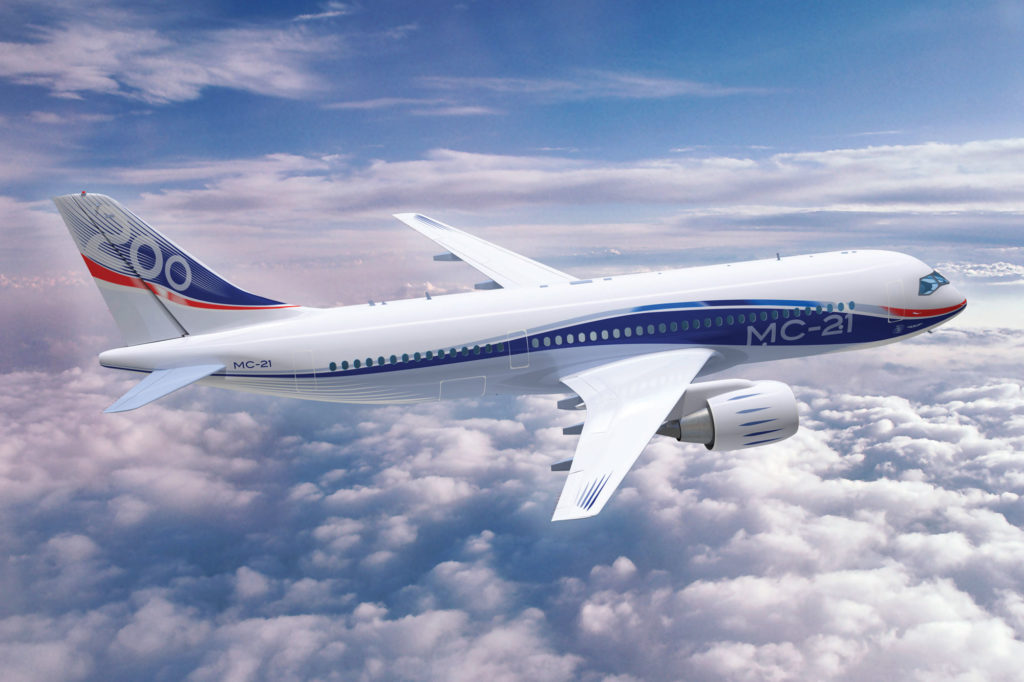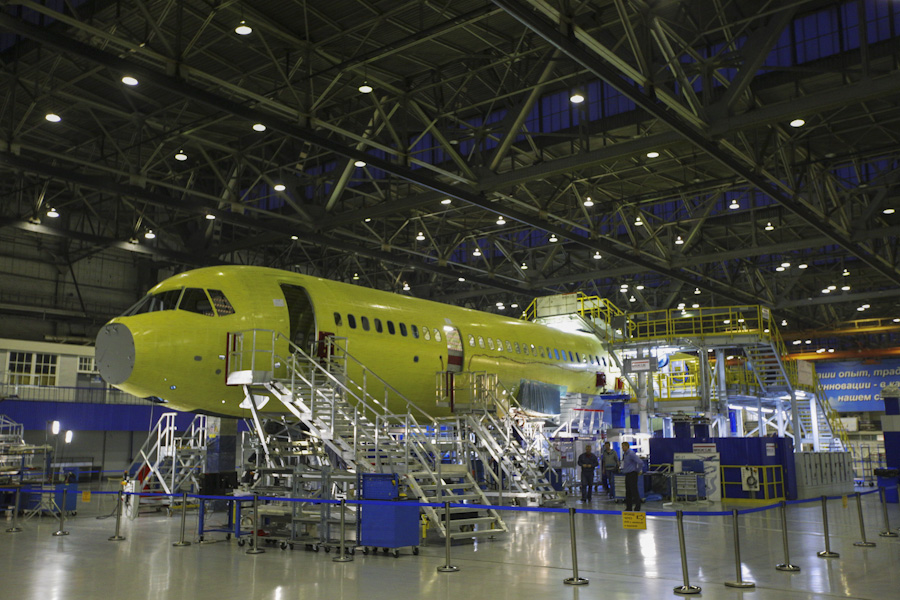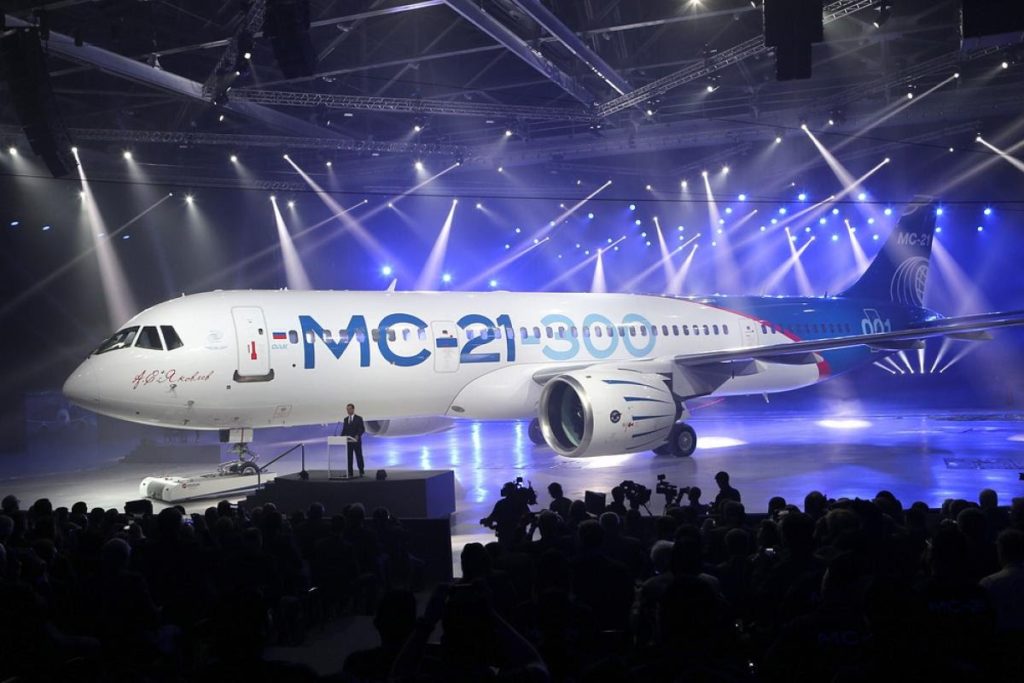Leeham News and Analysis
There's more to real news than a news release.
Russian-Chinese wide-body: The aircraft, Part 2
By Bjorn Fehrm
Subscription required.
Introduction
September 01, 2016, ©. Leeham Co: In Part 1, we concluded that the existing Il-96 fuselage cross section would be suitable for a new Russian-Chinese wide-body. This means that a lot of experience and existing designs for fuselage sections can be re-used.
Most importantly, it means that mock-ups and cabin sections can be made early in the project to start work on new and better cabin equipment. This is an area where the partners really lag their western competitors.
We will now look at what aircraft capacities can be conceived with the existing Il-96-300 and -400 fuselages and what changes will be necessary to achieve the targeted sizes that Russia’s United Aircraft Corporation (UAC) and Commercial Aircraft Corporation of China (COMAC) have communicated.
Summary:
- The IL-96 fuselage can be re-used for a Russian-Chinese wide-body.
- The existing IL96-300 cabin is on the small side whereas the Il-96-400 cabin is a bit larger than needed.
- The project will likely choose an intermediate size fuselage to reach the targeted 250 to 280 passenger capacity.
Russian-Chinese wide-body: The aircraft
By Bjorn Fehrm
Subscription required.
Introduction
August29, 2016, ©. Leeham Co: We have now covered the capabilities of the joint venture partners for a Russian-Chinese wide-body and its possible market. Now we will look at what kind of aircraft such a cooperation can create, given technology and other constraints.
There have been bits and pieces leaked to media from Russia’s United Aircraft Corporation (UAC) and Commercial Aircraft Corporation of China (COMAC).
We will look at what has been said and combine that with our knowledge of existing and future technological capabilities of the parties to make predictions for what aircraft the project can produce.
Summary:
- The Russian-Chinese wide-bodywill be made to cover the “small wide-body”market.
- Initial size will be a 250-280 passenger wide-body
- The aircraft will be a twin with engines from either GE or Rolls-Royce.
- Range with 280 passengers will be 6,500nm.
Russian-Chinese wide-body: The market
By Bjorn Fehrm
Subscription required.
Introduction
August 25, 2016, ©. Leeham Co: Having dissected the players behind the Russian-Chinese wide-body, it’s time to look at what market such an aircraft aims to capture.
The project participants, Russia’s United Aircraft Corporation (UAC) and Commercial Aircraft Corporation of China (COMAC), say they intend to make a 250-280 seat aircraft with a 6,500nm range.
We will look at what market such an aircraft can address from its Entry into Service (EIS) 2025 and over the next 10 years. We will also discuss the constrains that emerges with UAC and COMAC entering the market as new players.
Summary:
- The Russian-Chinese wide-body covers a market segment called “small wide-body” in the Global market forecast made by Airbus and Boeing.
- Based on data in these forecasts, the dominant market during the first 10 years after a 2025 Entry into Service (EIS) would be a captive Chinese market.
Russian-Chinese wide-body: background and outlook
By Bjorn Fehrm
Subscription required.
Introduction
August 21, 2016, ©. Leeham Co: The discussions around a joint Russian and Chinese development of a 250-300 seat wide-body has been going on for years.
The project got a more concrete form at President Putin’s visit to China in June. On the 25th of June visit, an inter-governmental agreement to develop and market the aircraft was signed.
At the same time Russia’s United Aircraft Corporation (UAC) and Commercial Aircraft Corporation of China (COMAC) agreed to establish a joint venture for the program.
What market is this aircraft trying to address and will it become a serious player in the wide-body market? Will it give the duopoly Airbus/Boeing something to worry about?
We will address these questions in a series of articles. Before going into the questions around the wide-body program, we will look at the players, UAC and COMAC. Are they up to the job of making a competitive wide-body aircraft?
Summary:
- Russia and China enter the wide-body project with widely different knowledge bases.
- China’s first airliner project, ARJ21, just received local certification after years of delays.
- Russia has produced over 10,000 airliners and has made two generations of wide-body aircraft in the size category.
- The latest wide-body aircraft, Ilyushin IL-96, is on the level of Airbus A340-300 from a technological basis.
What’s happened to the VLA sector?
Subscription Required
Introduction
Aug. 15, 2016, © Leeham Co.: Boeing says it may discontinue the 747 program.
Airbus put the A380neo on indefinite hold. Qantas Airways says it doesn’t want its last eight orders. The OEM will reduce the production to 12/yr in 2018.
There haven’t been any Boeing 777X sales since June 2015. There are only six identified customers and there has been a new, identified customer added since July

Boeing is considering a larger 777-10, which will carry 50 more passengers than the 777-9. But is there a market? Boeing photo via Google images.
2014, when ANA ordered the X.
Sales have dried up for the 365 passenger Boeing 777-300ER and only a smattering of orders have come in for its competitor, the Airbus A350-1000.
What’s happened to the Very Large Aircraft sector? What’s happened to the large, medium twin aircraft sector?
Summary
- The VLA market pioneered by Boeing and pursued by Airbus is virtually nonexistent.
- Yet there are those in Boeing who want to launch a 450-passenger 777-10 into a dubious market demand.
- 777 Classic sales dried up, but A350-1000 isn’t doing great, either. Are these too big, too?
Irkut MC-21-200 deepened analysis
By Bjorn Fehrm
Subscription required.
Introduction
August11, 2016, ©. Leeham Co: In February we did the first analysis of the Irkut MC-21-200. The analysis was made on the first data available. During the Farnborough Air Show, we got more information around the MC-21 and could see that an update of our first analysis was called for.
At the time we compared the MC-21-200 to Airbus A320 and concluded they are about the same size. With the new information, we could see that there is a size difference.
Summary:
- The MC-21-200 is close to Airbus A320neo in external dimensions, a bit smaller in the cabin and has lower take-off weights.
- Irkut, the OEM, suggested standard two class capacity is 132 seats. This is with space to spare in several places.
- To make a fair efficiency comparison with the A320neo, we develop an optimized cabin for the MC-21-200.
Boeing slightly leads Airbus in YTD orders
Aug. 8, 2016, © Leeham Co.: Boeing continues to lead Airbus in the race for orders post-Farnborough Air Show (FIA), but there are key orders announced there that haven’t been booked on the two OEMs order books.
Boeing hasn’t booked most of the firm orders yet from Volga Dnepr/Air Bridge Cargo announced at the show for 747-8Fs. Airbus hasn’t booked the 100 announced orders for A320s from AirAsia. Boeing also announced some 737 MAX orders that need to be firmed up into contracts before booking to its website.
The AirBridge orders will be closely watched. Boeing said at Farnborough that the MOU for 20 747-8Fs announced at the Paris Air Show a year earlier were now a firm contract, over six years. But Boeing and AirBridge did not say how many were firm orders, other than to identify four aircraft that were previously delivered under leases as part of the 20.
Reuters believes that 13 of the 20 are firm. Those four previous deliveries appear to be part of the 13, but this is unclear. Airfinance Journal reported that seven of the 20 will be taken by Boeing Capital Corp and leased to AirBridge. If true, this adds about $1bn to the Boeing balance sheet for customer financing.
This detail is important because AirBridge is very possibly the last customer that will order the 747-8. Boeing said it now has a backlog to 2019, but because the Airbridge transaction remains murky at best, the details are equally murky.
Drilling down into details of the orders placed through July:
Read more
Irkut MC-21-300 analysis, Part 3
By Bjorn Fehrm
Subscription required.
Introduction
August04, 2016, ©. Leeham Co: With the classification of the Irkut MC-21-300 done in terms of its size segment (it’s close to the Boeing 737 MAX 9 in size) and the key data of the aircraft analyzed, it’s now time to look at aircraft efficiency and payload-range performance.
We will do this with two cabin configurations for the aircraft. The first will be the nominal two class seating as proposed by the OEMs. For the second, we use a single class layout with 30-inch seat pitch.
Summary:
- The MC-21 has problems to compete with the re-engined 737 MAX 9 in terms of efficiency when using the standard two class cabins.
- When we switch to a single class high density layout, the fuel efficiency improves. The MC-21-300 exit concept is then more similar to the MAX 9, which affects efficiency in a positive way.
Irkut MC-21; we look at the MC-21-300, Part 2.
By Bjorn Fehrm
Subscription required.
Introduction
August 01, 2016, ©. Leeham Co: After having found the nearest competitor to the Irkut MC-21-300 as the Boeing 737 MAX 9 in our first article, we now go deeper in the comparison of the two aircraft.
In the first article, we found that the aircraft have almost identical cabin dimensions. Now we will look at other areas like airframe dimensions, weights and data which dictate overall performance.
Summary:
- The MC-21 has cabin dimensions which are very close to the 737 MAX 9.
- The nominal two class seating by Irkut is lower than the MAX 9. We have assumed that this will increase during the lifetime of the MC-21.
- We also compare other data between the MC-21-300 and the MAX 9, such as weights, wetted areas and effective wingspans to see if these are similar as well. In the end these dictate the aircraft’s efficiency together with the engines.






